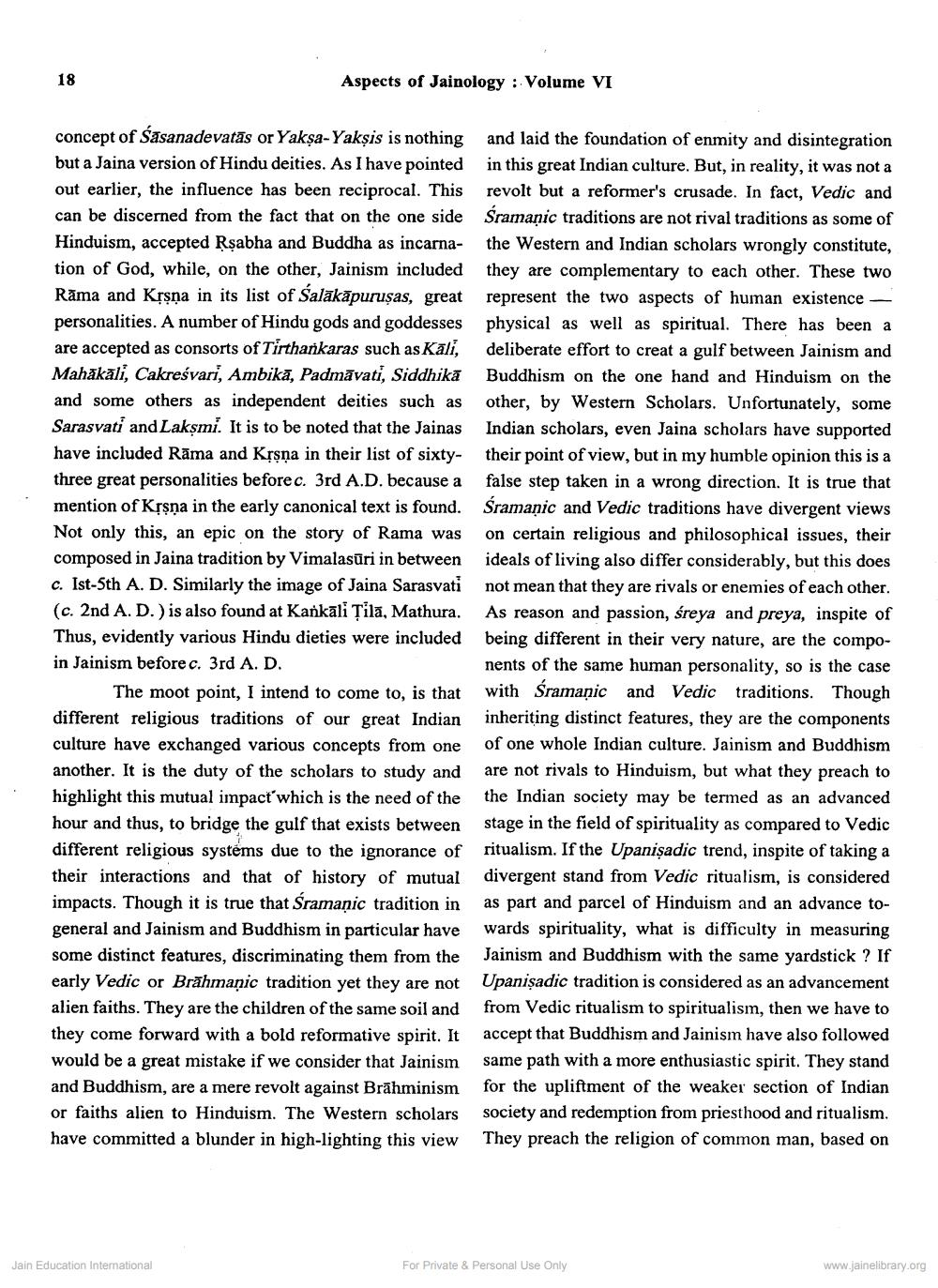________________
18
Aspects of Jainology: Volume VI
concept of Sasanadevatās or Yaksa-Yaksis is nothing but a Jaina version of Hindu deities. As I have pointed out earlier, the influence has been reciprocal. This can be discerned from the fact that on the one side Hinduism, accepted Rṣabha and Buddha as incarnation of God, while, on the other, Jainism included Rama and Krsna in its list of Salakāpurusas, great personalities. A number of Hindu gods and goddesses are accepted as consorts of Tirthankaras such as Kāli, Mahakali, Cakreśvari, Ambika, Padmavati, Siddhika and some others as independent deities such as Sarasvati and Laksmi. It is to be noted that the Jainas have included Rama and Kṛṣṇa in their list of sixtythree great personalities before c. 3rd A.D. because a mention of Kṛṣṇa in the early canonical text is found. Not only this, an epic on the story of Rama was composed in Jaina tradition by Vimalasūri in between c. Ist-5th A. D. Similarly the image of Jaina Sarasvati (c. 2nd A. D.) is also found at Kankali Ţilā, Mathura. Thus, evidently various Hindu dieties were included in Jainism before c. 3rd A. D.
The moot point, I intend to come to, is that different religious traditions of our great Indian culture have exchanged various concepts from one another. It is the duty of the scholars to study and highlight this mutual impact which is the need of the hour and thus, to bridge the gulf that exists between different religious systems due to the ignorance of their interactions and that of history of mutual impacts. Though it is true that Śramanic tradition in general and Jainism and Buddhism in particular have some distinct features, discriminating them from the early Vedic or Brahmanic tradition yet they are not alien faiths. They are the children of the same soil and they come forward with a bold reformative spirit. It would be a great mistake if we consider that Jainism and Buddhism, are a mere revolt against Brahminism or faiths alien to Hinduism. The Western scholars have committed a blunder in high-lighting this view
Jain Education International
and laid the foundation of enmity and disintegration in this great Indian culture. But, in reality, it was not a revolt but a reformer's crusade. In fact, Vedic and Śramanic traditions are not rival traditions as some of the Western and Indian scholars wrongly constitute, they are complementary to each other. These two represent the two aspects of human existence physical as well as spiritual. There has been at deliberate effort to creat a gulf between Jainism and Buddhism on the one hand and Hinduism on the other, by Western Scholars. Unfortunately, some Indian scholars, even Jaina scholars have supported their point of view, but in my humble opinion this is a false step taken in a wrong direction. It is true that Śramanic and Vedic traditions have divergent views on certain religious and philosophical issues, their ideals of living also differ considerably, but this does not mean that they are rivals or enemies of each other. As reason and passion, śreya and preya, inspite of being different in their very nature, are the components of the same human personality, so is the case with Śramanic and Vedic traditions. Though inheriting distinct features, they are the components of one whole Indian culture. Jainism and Buddhism are not rivals to Hinduism, but what they preach to the Indian society may be termed as an advanced stage in the field of spirituality as compared to Vedic ritualism. If the Upanisadic trend, inspite of taking a divergent stand from Vedic ritualism, is considered as part and parcel of Hinduism and an advance towards spirituality, what is difficulty in measuring Jainism and Buddhism with the same yardstick? If Upanisadic tradition is considered as an advancement from Vedic ritualism to spiritualism, then we have to accept that Buddhism and Jainism have also followed same path with a more enthusiastic spirit. They stand for the upliftment of the weaker section of Indian society and redemption from priesthood and ritualism. They preach the religion of common man, based on
For Private & Personal Use Only
www.jainelibrary.org




